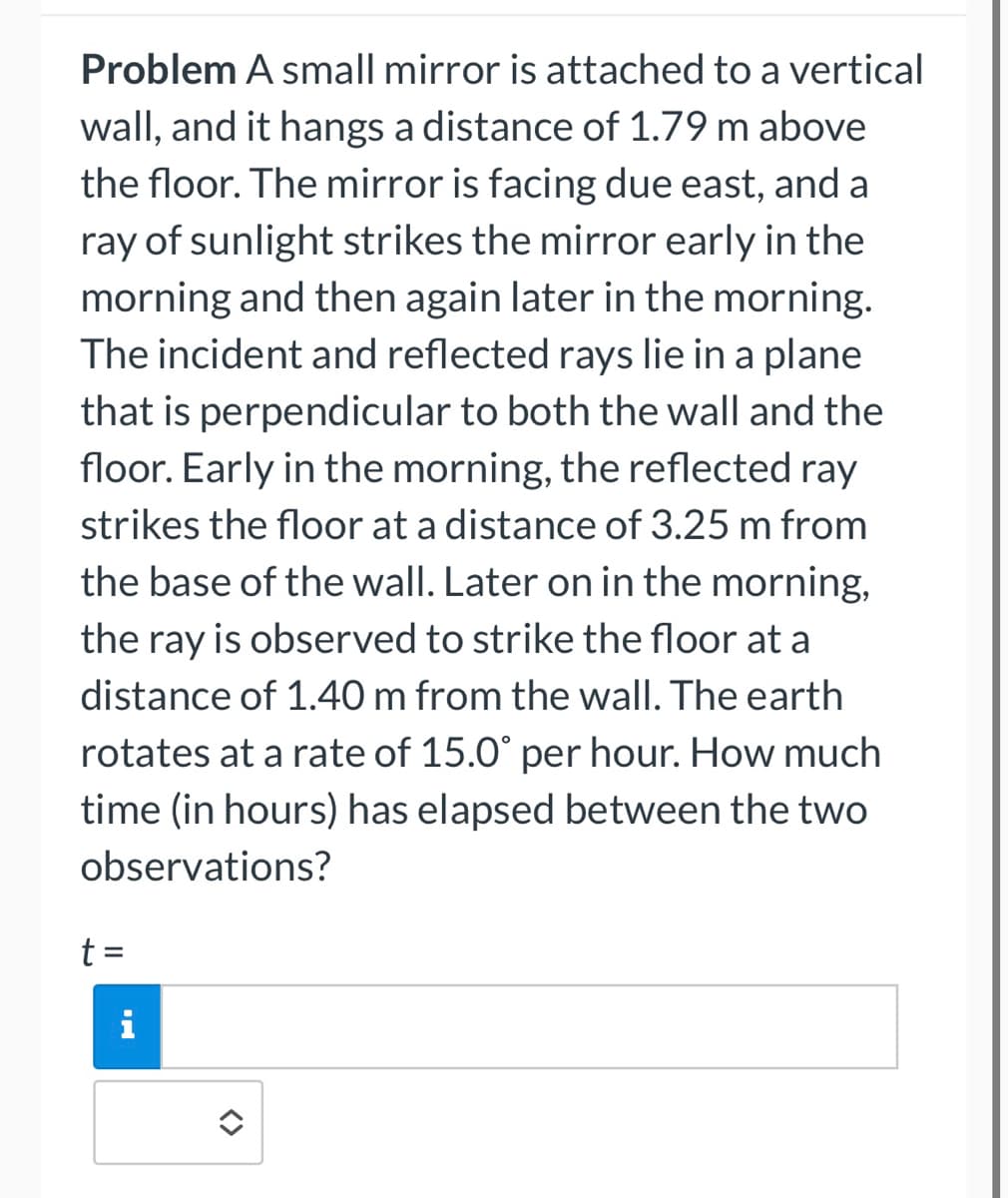Problem A small mirror is attached to a vertical wall, and it hangs a distance of 1.79 m above the floor. The mirror is facing due east, and a ray of sunlight strikes the mirror early in the morning and then again later in the morning. The incident and reflected rays lie in a plane that is perpendicular to both the wall and the floor. Early in the morning, the reflected ray strikes the floor at a distance of 3.25 m from the base of the wall. Later on in the morning, the ray is observed to strike the floor at a distance of 1.40 m from the wall. The earth rotates at a rate of 15.0° per hour. How much time (in hours) has elapsed between the two observations? t = i <>
Problem A small mirror is attached to a vertical wall, and it hangs a distance of 1.79 m above the floor. The mirror is facing due east, and a ray of sunlight strikes the mirror early in the morning and then again later in the morning. The incident and reflected rays lie in a plane that is perpendicular to both the wall and the floor. Early in the morning, the reflected ray strikes the floor at a distance of 3.25 m from the base of the wall. Later on in the morning, the ray is observed to strike the floor at a distance of 1.40 m from the wall. The earth rotates at a rate of 15.0° per hour. How much time (in hours) has elapsed between the two observations? t = i <>
Principles of Physics: A Calculus-Based Text
5th Edition
ISBN:9781133104261
Author:Raymond A. Serway, John W. Jewett
Publisher:Raymond A. Serway, John W. Jewett
Chapter26: Image Formation By Mirrors And Lenses
Section: Chapter Questions
Problem 3OQ
Related questions
Concept explainers
Applications Of Reflection Of Light
When a light ray (termed as the incident ray) hits a surface and bounces back (forms a reflected ray), the process of reflection of light has taken place.
Sign Convention for Mirrors
A mirror is made of glass that is coated with a metal amalgam on one side due to which the light ray incident on the surface undergoes reflection and not refraction.
Question

Transcribed Image Text:Problem A small mirror is attached to a vertical
wall, and it hangs a distance of 1.79 m above
the floor. The mirror is facing due east, and a
ray of sunlight strikes the mirror early in the
morning and then again later in the morning.
The incident and reflected rays lie in a plane
that is perpendicular to both the wall and the
floor. Early in the morning, the reflected ray
strikes the floor at a distance of 3.25 m from
the base of the wall. Later on in the morning,
the ray is observed to strike the floor at a
distance of 1.40 m from the wall. The earth
rotates at a rate of 15.0° per hour. How much
time (in hours) has elapsed between the two
observations?
t =
i
Expert Solution
This question has been solved!
Explore an expertly crafted, step-by-step solution for a thorough understanding of key concepts.
This is a popular solution!
Trending now
This is a popular solution!
Step by step
Solved in 2 steps with 2 images

Knowledge Booster
Learn more about
Need a deep-dive on the concept behind this application? Look no further. Learn more about this topic, physics and related others by exploring similar questions and additional content below.Recommended textbooks for you

Principles of Physics: A Calculus-Based Text
Physics
ISBN:
9781133104261
Author:
Raymond A. Serway, John W. Jewett
Publisher:
Cengage Learning

Physics for Scientists and Engineers: Foundations…
Physics
ISBN:
9781133939146
Author:
Katz, Debora M.
Publisher:
Cengage Learning

Physics for Scientists and Engineers, Technology …
Physics
ISBN:
9781305116399
Author:
Raymond A. Serway, John W. Jewett
Publisher:
Cengage Learning

Principles of Physics: A Calculus-Based Text
Physics
ISBN:
9781133104261
Author:
Raymond A. Serway, John W. Jewett
Publisher:
Cengage Learning

Physics for Scientists and Engineers: Foundations…
Physics
ISBN:
9781133939146
Author:
Katz, Debora M.
Publisher:
Cengage Learning

Physics for Scientists and Engineers, Technology …
Physics
ISBN:
9781305116399
Author:
Raymond A. Serway, John W. Jewett
Publisher:
Cengage Learning

College Physics
Physics
ISBN:
9781938168000
Author:
Paul Peter Urone, Roger Hinrichs
Publisher:
OpenStax College

University Physics Volume 3
Physics
ISBN:
9781938168185
Author:
William Moebs, Jeff Sanny
Publisher:
OpenStax

College Physics
Physics
ISBN:
9781285737027
Author:
Raymond A. Serway, Chris Vuille
Publisher:
Cengage Learning